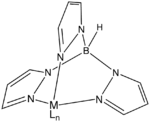Potassium trispyrazolylborate
 | |
| Names | |
|---|---|
| IUPAC name
Potassium tri(1H-pyrazol-1-yl)hydroborate | |
| Identifiers | |
| 18583-60-3 | |
| 3D model (Jmol) | Interactive image Interactive image |
| ChemSpider | 2007131 |
| ECHA InfoCard | 100.203.487 |
| PubChem | 2725019 |
| |
| |
| Properties | |
| C9H10BKN6 | |
| Molar mass | 252.13 g·mol−1 |
| Melting point | 188 to 189 °C (370 to 372 °F; 461 to 462 K)[1] |
| Except where otherwise noted, data are given for materials in their standard state (at 25 °C [77 °F], 100 kPa). | |
| | |
| Infobox references | |
Potassium trispyrazolylborate, commonly abbreviated KTp, is the potassium salt of the trispyrazolylborate ligand.[1]
KTp is a white crystalline solid which is soluble in polar solvents, alcohols, and water. The synthesis of KTp involves potassium borohydride and pyrazole without a solvent.[2]
- KBH4 + 3 pzH → KTp + 3 H2

Idealized structure of a Tp ligand bound to a metal center MLn.
The tris(pyrazolyl)borate forms octahedral coordination compounds with the formula M[Tp]2 with first row transition metals. KTp also forms 1:1 complexes, for example it can be converted to K[TpMo(CO)3];
- KTp+Mo(CO)6→K[TpMo(CO)3 ]+ 3CO
When K[TpMo(CO)3] is treated with butyl nitrite it yields the neutral orange complex TpMo(CO)2NO.[3]
- K[TpMo(CO)3]+ BuONO→TpMo(CO)2NO+CO+KOBu
References
- 1 2 Trofimenko, Swiatoslaw (1967). "Boron-pyrazole chemistry. II. Poly(1-pyrazolyl)-borates". J. Am. Chem. Soc. 89: 3170. doi:10.1021/ja00989a017.
- ↑ Trofimenko, Swiatoslaw (1970). "Poly(1-Pyrazolyl)Borates, their Transition-Metal Complexes, and Pyrazaboles". Inorg. Syn. 12: 99. doi:10.1002/9780470132432.ch18.
- ↑ Trofimenko, Swiatoslaw (1999). "Scorpionates: Polypyrazolylborate Ligands and Their Coordination Chemistry.". World Scientific Publishing Company.
This article is issued from Wikipedia - version of the 8/24/2016. The text is available under the Creative Commons Attribution/Share Alike but additional terms may apply for the media files.